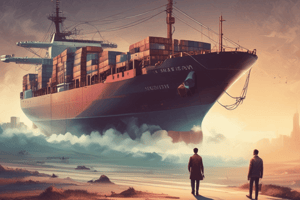Podcast
Questions and Answers
Which statement correctly distinguishes between goods and services?
Which statement correctly distinguishes between goods and services?
- Goods are produced before consumption, while services are consumed as they are produced. (correct)
- Services can be stored for future use.
- Goods are intangible and cannot be seen or touched.
- Services can be transferred from one person to another.
What is an example of economic goods?
What is an example of economic goods?
- Rainwater
- Food (correct)
- Air
- Sunlight
Which type of goods can be used repeatedly over a long period?
Which type of goods can be used repeatedly over a long period?
- Durable goods (correct)
- Private goods
- Economic goods
- Single-use goods
What defines a public good?
What defines a public good?
Which of the following is an example of a producer service?
Which of the following is an example of a producer service?
Which statement is true regarding free services?
Which statement is true regarding free services?
What is an example of a single-use good?
What is an example of a single-use good?
Which characteristic best defines private goods?
Which characteristic best defines private goods?
Flashcards
What are goods?
What are goods?
Goods are physical objects that can be touched and used to satisfy needs. Examples include food, clothing, and furniture.
What are services?
What are services?
Services are actions or activities performed for others to satisfy needs. Examples include hairdressing, transportation, and education.
What are free goods?
What are free goods?
Free goods are naturally available and do not require payment. Examples include air, sunlight, and rainwater.
What are economic goods?
What are economic goods?
Signup and view all the flashcards
What are consumer goods?
What are consumer goods?
Signup and view all the flashcards
What are producer goods?
What are producer goods?
Signup and view all the flashcards
What are private goods?
What are private goods?
Signup and view all the flashcards
What are public goods?
What are public goods?
Signup and view all the flashcards
Study Notes
Goods and Services
- Goods are tangible and can be seen and touched, used to satisfy needs.
- Services are intangible, cannot be seen or touched and focus on doing something for someone to satisfy a need.
- Goods are produced before they are consumed, there is a time lag between production and consumption.
- Services are consumed as they are produced, with no time lag between production and consumption.
- Goods can be stored and used later, while services cannot be stored but must be used as they are produced.
- Goods can be transferred from one person to another, while services cannot be transferred.
Classification of Goods and Services
Free Goods and Economic Goods
- Free goods are naturally available and do not require a price (rainwater, air, sunlight).
- Economic goods are scarce and require a price (food, clothing, transport).
Free Services and Economic Services
- Free services are not paid for and are often provided by family members (care from parents).
- Economic services are services for which someone is paid (doctors, teachers, cleaners).
Consumer Goods and Producer Goods
- Consumer goods are directly used by consumers to fulfil their needs (mobile phone, car, food).
- Producer goods are used by producers to produce other goods (machinery, raw materials, buildings).
Consumer Services and Producer Services
- Consumer services are services consumed by individuals (tailor’s services, doctor’s services).
- Producer services are services used by businesses to produce other goods and services (legal services, banking services).
Single-Use Goods and Durable Goods
- Single-use goods are goods that can be used only once (food, fuel, stationery).
- Durable goods are goods that can be used repeatedly over a long period (furniture, appliances, vehicles).
Private Goods and Public Goods
- Private goods are excludable and rivalrous, meaning individuals can be prevented from using them and one person’s use reduces another's ability to use them (car, house, clothes).
- Public goods are non-excludable and non-rivalrous, meaning everyone can use them and one person’s use does not limit another's ability to use them (roads, parks, national defense).
Significance of Goods and Services
- Goods and services are essential for satisfying human needs and wants (food, clothing, education, healthcare).
- Goods and services are necessary for production (raw materials, equipment).
- Goods and services are used for investment purposes (machines, buildings).
Studying That Suits You
Use AI to generate personalized quizzes and flashcards to suit your learning preferences.



